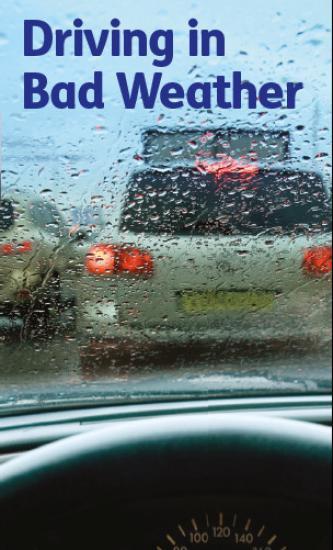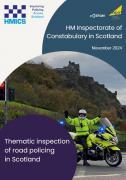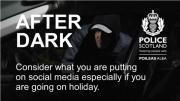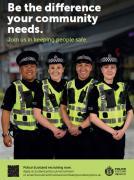
This site uses cookies, by continuing to use this site you accept the terms of our privacy policy
Feed 2.0 Loading...
Stay Safe On The Roads This Winter
20th October 2014

Police Scotland advises motorists to be prepared for bad road conditions.
Prepare for the winter by keeping your vehicle well maintained before you take to the road. Reduced daylight hours and the possibility of inclement weather place additional demands on all road users.
Tips and advice on staying safe this winter
Take special care that brakes, tyres, lights, batteries, windscreens and wiper blades are in good condition and well maintained. In addition, washer bottles need to contain an additive to stop the water from freezing.
Plan ahead. Check the forecast, road conditions and consider alternative routes. Allow extra time for your journey and check your planned route is free from delays.
When did you last check your tyres? Tyres should be checked weekly to ensure they are legal and at the correct pressure (check the vehicle handbook). The minimum legal tread depth for cars is 1.6mm across the centre ¾ of the breadth of the tread around the entire circumference (1 mm for motorcycles). They should also be checked for bulges, cuts or tears which will weaken the tyre. Failure to maintain your tyres could lead to a maximum of £2,500 fine and 3 penalty points per tyre.
Windscreens, wiper blades and windows must be kept clean and free from defects. Make sure it is properly demisted and clear of snow and ice before you drive. Low sun can make it difficult to see and a dirty, greasy or damage windscreen can make this worse.
All lights including reflectors must be kept clean and clear and be in good working order. This includes registration plate lights. Cyclists must have white front and rear red lights lit at night. Be seen and be safe.
Change the way you drive
Bad weather is often blamed for causing accidents, but the real cause is inappropriate driving for the conditions that exist.
In wet weather stopping distances will be at least double those required for stopping on dry roads. Aquaplaning can be a frightening experience. This is where a wedge of water builds up between the front tyres and the road surface. The safest solution is to remove the pressure from the accelerator, allowing the vehicle to lose speed and the tyres to regain their grip.
Keep well back from the road user in front in icy or snowy weather. Stopping distances can be ten times greater. When the roads are icy, drive at slow speed in as high a gear as possible; accelerate and brake very gently.
High-sided vehicles are most affected by windy weather. Motorcyclists and cyclists can easily be blown off course particularly in open stretches of road exposed to strong crosswinds.
When driving in fog use dipped headlights so other drivers can see you. Fog lights can only be used when visibility is seriously reduced to less than 100 metres but they must be switched off if visibility improves. Be prepared for a bank of fog or drifting patchy fog ahead. Even if it seems to be clearing, you can suddenly find yourself in thick fog.
Avoid driving in icy or snowy conditions unless your journey is essential. If you do you, we recommend you take an emergency kit of: scraper, de-icer, torch, first aid kit, jump leads, shovel, warm drink and emergency food in case you get stuck or break down.
Extra points to remember
Cyclists should have suitable lights on their bicycles and wear reflective and fluorescent clothing and a cycle helmet.
Parents of children who do paper rounds during the hours of darkness at this time of year should ensure their children are given this protection.
Pedestrians should ensure they wear bright clothing, particularly in rural areas where the street lighting is either non-existent or very limited.
Further information
Traffic Scotland - http://www.trafficscotland.org/
Transport Scotland - http://www.transportscotland.gov.uk/
Ready Scotland - http://www.scotland.gov.uk/Topics/Justice/public-safety/ready-scotland
For more information or advice please contact the Road Safety Unit on 0141 337 1725
See the leaflet - Safe Driving In Bad Weather Conditions
Related Businesses
Related Articles
6/11/2024
Police - Area Performance Report to Caithness Area Committee on 11 November
A report by the police to the Caithness area committee on 11 November will allow councillors to discuss a range of issues. Chief Inspector Calum Smith - Area Commander (North Highland Area Command) sets out the crime related figures up to June 2024.5/11/2024
Police Scotland Urged To Review Its Commitment To Road Policing
A reduction in police activity targeting the most common causes of fatal crashes has been identified as a key factor affecting Police Scotland's ability to keep people safe on the nation's roads. A new report by His Majesty's Inspectorate of Constabulary in Scotland notes that since 2020 the total number of people killed or injured on Scotland’s roads has increased each year.
2/9/2024
A836 In Caithness - Average Speed Cameras Go Live Today Monday 2nd September
Police Scotland's North Safety Camera Unit are now operating average speed cameras on the A836 between Reay and Thurso with offences being progressed from Monday 2nd September. In partnership with the Scottish Safety Camera Programme and the Highland Council, the location was identified as having speed concerns and increased traffic volumes, both of which are potential ongoing road safety challenges.
3/12/2023
Visiting relatives and friends this Christmas? Make sure your home is safe AFTER DARK
Consider carefully what you are putting on social media, especially if you are staying away to visit friends and relatives this Christmas. Be wary of posting photographs of Christmas parties that contain images of high value jewellery.
23/9/2023
POLICE OFFICER RECRUITMENT - CAITHNESS AREA
Would you like to join the Police? Would you like to live and work in the Caithness area? Police Scotland is actively recruiting good quality and eligible candidates specifically for the Caithness area. We are taking applications now for Police Constable / Special Constable Entry for future intakes during 2023/2024.
2/7/2023
£74m Police Budget Cut Will Make Communities Less Safe
UNISON, the union for police staff, says Scotland's police budget cut will see even more crime going unreported and crimes not being fully investigated. The union says around 230 police staff could be cut, including fingerprint examiners, forensic examiners, 999 call handlers, custody staff, high-speed driving instructors, cybercrime experts, payroll, HR and IT staff.19/1/2023
New Police Commander For Highland And Islands Division Takes Oath
The new Highland and Islands divisional commander will take up post having been sworn in as a Police Scotland officer. Chief Constable Sir Iain Livingstone welcomed and thanked Chief Superintendent Rob Shepherd during a ceremony at Police Scotland Headquarters, Tulliallan, on Monday, 16 January 2023, overseen by Justice of the Peace Gillian Thomson.
1/12/2022
Police Complaints, Investigations And Misconduct To Continue After Resignations
Gross misconduct proceedings against police officers should be allowed to continue after they resign from the force to promote transparency and maintain public confidence, according to a public consultation. The move, which would see proceedings continue even if an officer leaves during the course of an investigation into their conduct, was among the recommendations of Dame Elish Angiolini's independent review into how police complaints and allegations of misconduct should be handled.21/6/2022
Criminal Proceedings In Scotland 2020-21
The total number of people proceeded against in Scottish courts fell by 46% to 46,497 in the year to 2020-21, according to National Statistics published by Scotland's Chief Statistician today. The number of people convicted fell at a similar rate, down 44% to 42,532.9/2/2021


